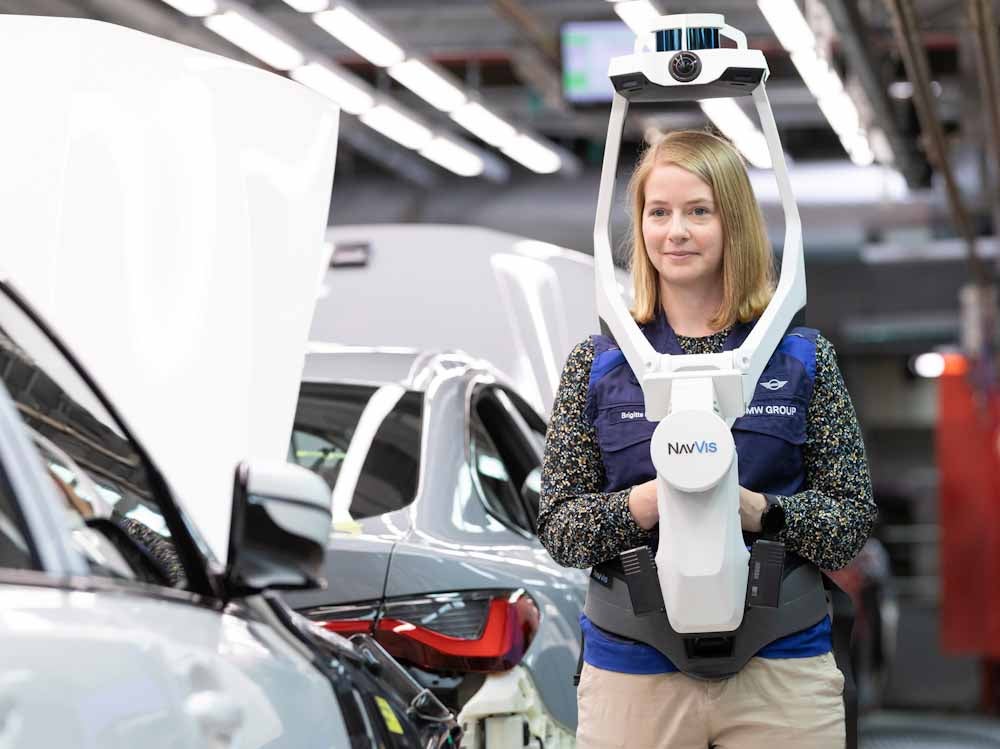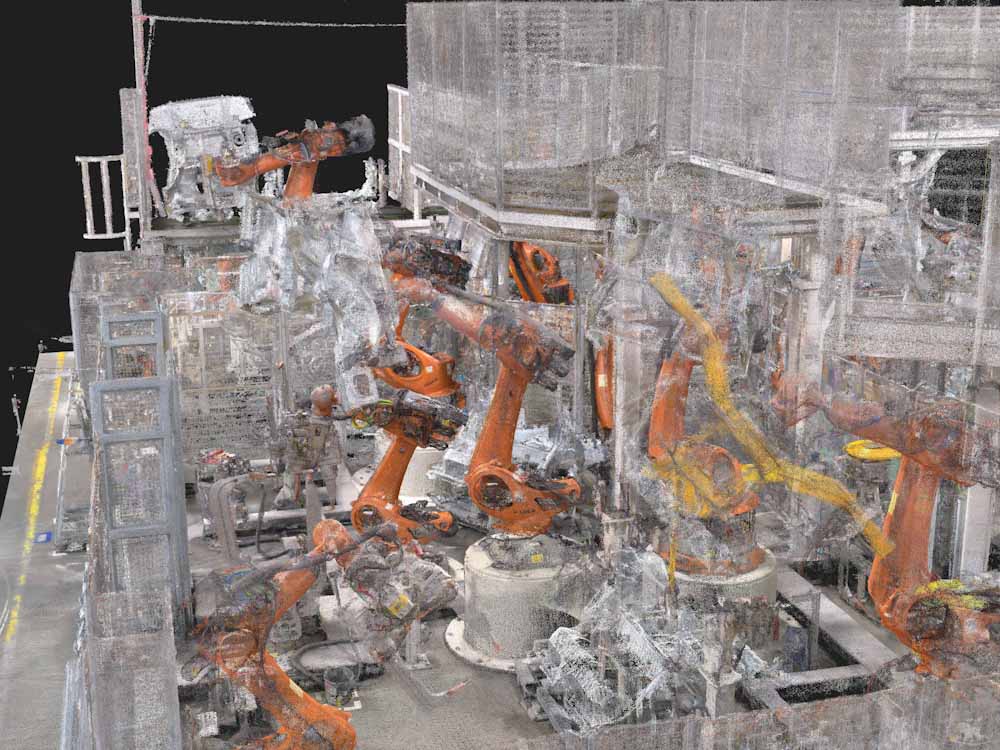
The automotive industry is increasingly turning to digital technologies to address many aspects of production, and 100% digital scans of facilities offer numerous advantages as manufacturing requirements evolve.
With the phasing out of new petrol and diesel engines beginning in the next decade in certain countries, automotive manufacturers must adapt facilities to meet the increasing demand for electric vehicles (EVs) globally.

Discover B2B Marketing That Performs
Combine business intelligence and editorial excellence to reach engaged professionals across 36 leading media platforms.
Provided the trajectory of EVs continues on the current course, GlobalData estimates that the lithium-ion battery market will be worth $408.3bn by 2035. This is up from the $88.6bn estimated in 2022, increasing by a 12.5% compound annual growth rate (CAGR) over this period. Most batteries will be used in the automotive industry.
To accommodate this extra demand, many automotive manufacturers are adapting conveyors to manage the extra weight of EVs. Some automotive manufacturers are also building battery production plants on existing sites. However, with new battery technologies also in development – such as solid-state units and sodium-ion alternatives – the more flexibility that automotive manufacturers have to adapt to emerging trends, the stronger position they will be in.
To achieve this flexibility, reality capture technologies provide many practical advantages – particularly through 100% scans of production facilities. Complete spatial data and panoramic images can be captured by mobile scanning devices to provide precise, up-to-date digital representations of production sites.
Data can be leveraged in multiple ways, offering automotive manufacturers full visibility across their entire production network. Locations where work is required can be planned with precision. Furthermore, uses of similar technology extend beyond automotive original equipment manufacturers (OEMs). Tier 1 suppliers are also using this type of technology to capture data amid a move in a similar direction. The more data from facilities that is captured, the greater the possibilities.
How 100% scans offer advantages for automotive manufacturers
For automotive manufacturers scanning an entire production network, the spatial data and images from scanned environments can be shared with a large proportion of the workforce and stakeholders. Data and images can be accessed remotely from anywhere in the world.
With 100% scans, teams can optimize workflows to improve efficiencies during production planning. Due to the increased oversight available, scanning also reduces the potential for extra costs from late changes to production.
However, automotive manufacturers that fail to scan the whole production network will inevitably have blind spots where data has not been captured. Consequently, this can mean that decision-making on a business-wide project is compromised and can lead to misunderstandings.
“When the whole factory is not scanned, the planning process may be affected as key elements are excluded and can affect decisions such as those around manufacturing costs,” explains Paul Hänchen, senior strategy manager at NavVis, a specialist provider of reality capture and digital factory solutions.
“From a single factory planner’s perspective, it’s fine to see the part of the project which is relevant to them. However, for the key stakeholders in the organization who are involved in the decision-making process, it is vital that they can view the whole production network. For example, if they want to relocate products or optimize, extend, or even shut down the existing factory,” adds Hänchen.
“If there are 2,000 factory planners and each one of them wants to view a specific area in the factory, there would need to be a wider scan of the factory to obtain this data.”
One automotive company that has benefitted from 100% scans is BMW. Mobile mapping technologies enabled the company to scan all its vehicle plants. Approximately 15,000 BMW workers are now using this data in their workflows, inspecting facilities, and planning future works with external suppliers.
Overcoming challenges with 100% scans in production facilities
While many manufacturers have embraced technology, the automotive industry remains restricted by legacy mindsets. In the past, generating a complete scan of a production network was not a simple task. Advances in technology have enabled greater accessibility to scanning solutions, enabling businesses to leverage data in ways that haven’t been possible before.
“There may be misconceptions with implementing technology in the past as the technology was not user-friendly – the data size and the computational effort and the resources required to capture the data was significantly higher than what it is today,” says Nate McCall, senior solutions manager at NavVis.
Nevertheless, mobile mapping technology is becoming more widely used in automotive production as the benefits become clearer. Scanning devices can capture comprehensive spatial data as the operator walks through a facility, providing vital information to help improve the efficiency of production planning and operations.
When a complete scan of a production network is generated using mobile mapping technology, it allows businesses to plan workflows with greater precision and greatly reduce any errors in production. This avoids potential downtime that could be caused by inaccurate planning and also eliminates the knock-on extra costs.

Optimizing automotive production with scanning tech
NavVis offers a suite of mobile mapping and laser scanning solutions that deliver greater accessibility of spatial data and visuals of facilities, improve collaborations between different teams, and enhance transparency among stakeholders.
NavVis VLX is a wearable scanning system that enables the complete capture of spatial data from a production facility, along with 360° panoramic images. The device can capture environments faster than a terrestrial laser scanner.
Data and images are uploaded instantly via the cloud and viewable on NavVis IVION, which is the company’s cloud and web based reality capture platform. The platform allows users to access and manage visualized point cloud data remotely. Through the platform, it is possible to quickly switch between different facilities within a production network, and has been designed for compatibility with related third-party software.
“We have proven with a lot of our current enterprise customers that we can do 100% scans. We’ve supported that with the ease-of-use of our products, and also the development of the algorithms that have enabled mobile mapping,” says McCall.
“It enables users to quickly get to grips with how to use the technology as it can be very technical. If our technology is more accessible, and a little bit more digestible, it leads people wanting to use our software. It also enables customers to keep that data up-to-date to get as much trusted data in front of as many people as possible.”
Data-driven decision-making in vehicle manufacturing
When automotive manufacturers are in the production planning stage, NavVis technology enables them to make better decisions, according to Hänchen.
“When using IVION to capture data about their factory, users can go into the specifics of how the factory is operating,” says Hänchen. “For example, users can change the layout, check forklift routes, find alternative areas to relocate equipment, and share best practices with another factory – enabling them to reduce costs and increase productivity.”
Regularly rescanning the production network is vital to ensure that the data of production networks is kept up-to-date and reliable. This is especially important if there are regular changes being made to the factory layout and decisions taken based on that data. For example, when fitting new doors, walls, or entire manufacturing lines, the latest spatial data and images can be captured from the specific areas where changes are required and again after the completion of works.
“With rescanning it’s easy to capture accurate data as there is no need to scan the whole factory again. Also, thanks to mobile mapping, it’s a lot easier than it was in the past to execute the rescan. A manufacturer can scan the part of the factory that is new or needs updating,” says Hänchen.
Furthermore, the data visibility editor on IVION allows users to hide old data so that only the newest information is displayed. This is particularly useful for removing areas that overlap when there have been re-scans, adding to the clarity of the digital environment. All these advantages help to streamline automotive production, enhance planning capabilities, increase transparency throughout the network, and ultimately help to reduce manufacturing costs.
To learn more about how digital factory solutions can optimize automotive production, download the specially commissioned white paper below.


